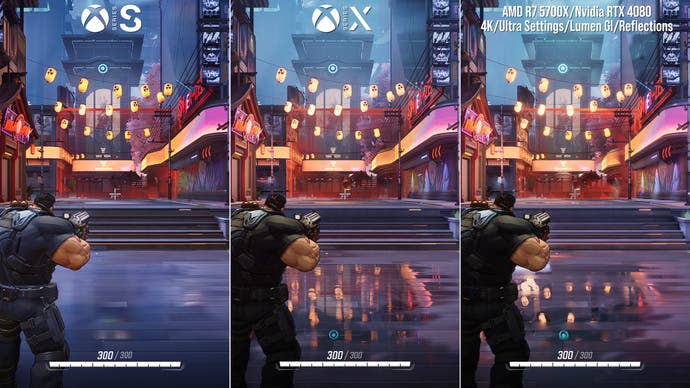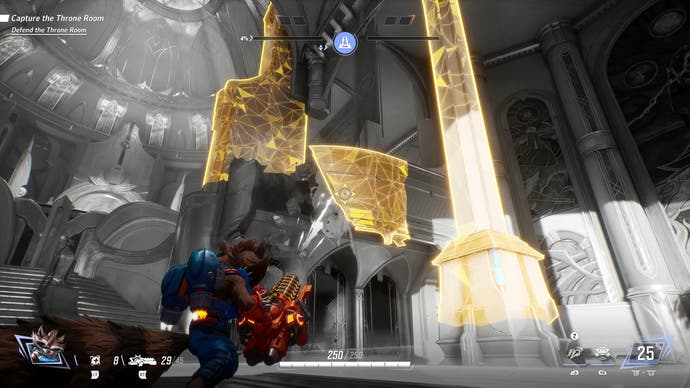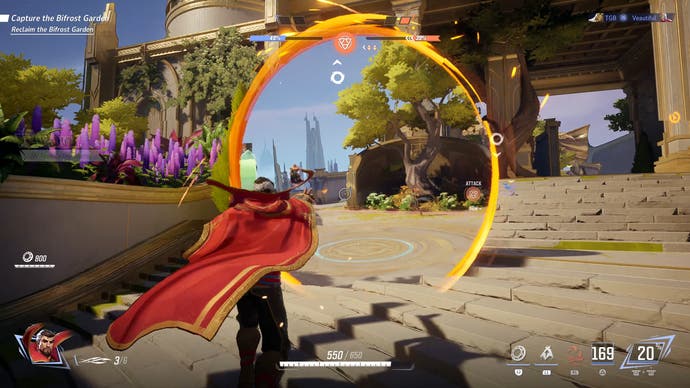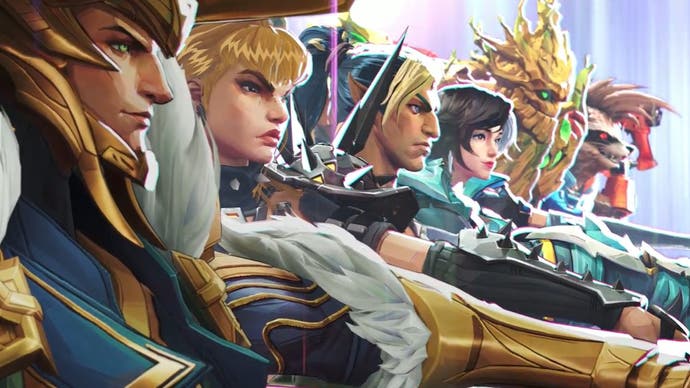Marvel Rivals pushes Unreal Engine 5 hard - and Series S can't quite hack it
A promising, boundary-pushing hero shooter with work to do before it emerges from beta status.
Marvel Rivals is the second new hero shooter to arrive in beta form this month, following on from Sony's Concord as another team-based multiplayer affair. This time though, it's a full cross-platform release, with Xbox Series X and Series S joining PS5 and PC. Rivals also goes further in using the Unreal Engine 5 feature set, with Lumen global illumination and reflections, and features a third-person perspective of the titular heroes and villains that sets it apart from the likes of Overwatch. Early impressions suggest a more deeply ambitious game, but one that also comes with more profound technical challenges in its current form.
We've tested every platform to see how they compare, paying special attention to PS5, Series X and Series S to see how closely they manage to hold to the target 60fps - and in the case of the Series S, how much they sacrifice to get there with more modest hardware. Beyond that, how do these platforms hold up to the game running maxed out on PC, with Lumen GI and reflections set to ultra, and what technical gremlins lurk behind that beta badge?
Before we answer these questions, it's worth looking at the state of play right now. After all, this is a beta in flux, with 21 characters and four map variants on offer during our testing. Developers NetEase Games are no strangers to genre giant Overwatch, having worked on creating versions of the title and other Blizzard releases for the Chinese market, and that comes across in the presentation: slick, snappy and broadly similar.
Beyond its comic book cast and newer tech, there are two key twists here. The first is the use of destructible environments, where it's possible to chip away parts of the map to reveal new lines of sight or even remove routes entirely. Bridges break, chandeliers fall, and pillars and walls collapse. To see which parts are destructible, you simply hold right on the d-pad to raise an alternative x-ray view of the stage. All round, it's a well-worked mechanic that adds an extra, chaotic dynamic to each map that doesn't exist in Rivals' rival titles.
Secondly, there are the super hero abilities of Marvel Rivals, which are more extreme - and performance-taxing - than what you'll find in Concord or Overwatch. Spider-Man, Iron Man and Storm all have a means to essentially fly through the stage - and in the case of Spider-man's web-slinging, there's an outrageous level of agility that demands quick streaming of level assets. The camera and controls sometimes struggle to keep up with the motion, which is perhaps best suited for exterior areas.
Other characters also have a unique gimmick that puts a high level of GPU strain on consoles and PC. In this case, Doctor Strange is able to summon a portal to any place on the map. Much in the same vein as Valve's Portal titles, this allows teammates and enemies alike to cross or fire through to another area of the map. Everything combined - the presence of map destruction physics, plus these more outlandish abilities - make the game an inherently more technically demanding concept to pull off. Add in the support for Unreal Engine 5's Lumen GI and Lumen reflections, and it's a much more ambitious effort than what we were expecting.
These design choices mean that ensuring a stable 60fps is more challenging than we normally see in a game of this type, and that holds true across PS5, Series X and Series S. In terms of settings, there's little to split the two premium machines, with both targeting a 1440p output and using dynamic resolution scaling all the way down to 810p to stabilise GPU load. Both PS5 and Series X get the same Lumen GI setting between them too, plus screen space reflections rather than the Lumen reflections possible on PC.
As ever, it's the 4TF Series S that distinguishes itself, taking major cutbacks in visual features to hit the same 60fps target. That means a lesser 972p target resolution that drops to 540p at lowest, accompanied by a drop in texture resolution too. And it doesn't stop there: Rivals on Series S also completely lacks character shadows, Lumen GI is stripped out in favour of simpler screen-space shading, and screen-space reflections are removed as well in favour of less complex cubemaps. It's a disappointing result for Series S owners that sees basically all of the game's visual niceties removed.
None of this is to call Series X or PS5, the absolute best place to play Marvel Rivals, but these platforms acquit themselves well by comparison. Unsurprisingly it's PC that offers the highest visual fidelity, with Series X and PS5 coming in below both the high and ultra settings for Lumen GI with a better-than-medium result that seems to sacrifice tracing accuracy to ensure performance. In UE5's dev tools, this potentially relates to the "final gather quality" variable - the resolution at which the final effect of the shading is resolved, after calculating the light bounce. This might be improved come Marvel Rival's final launch, but as it stands in the beta, it does fall short of the Lumen GI settings on PC.

As mentioned earlier, Lumen reflections are absent on console, with SSR used instead and identifiable by the usual occlusion artefacts (once an object falls out of the screen's view, that detail disappears in the reflections as well). Admittedly, on PC the Lumen reflection setting still uses a hybrid approach that blends software ray tracing and SSR for performance reasons, but accuracy is at least improved versus console. Comparing Series S, Series X and PC, there's a clear cascade in quality, leaving Series S very much behind in the best visual features Marvel Rivals has to offer.
Switching over to performance testing, all three consoles are easy to summarise. 60fps is well held 95 percent of the time, but that remaining five per cent sticks out for various reasons. Most egregiously there are map traversal hitches, with more rapid forms of travel - like Iron Man and Spider-Man's more agile movement in the air - exacerbating the issue. For a competitive game so dependant on a consistent 60fps lock, it's jarring to see. This could have roots in networking issues, and of course Rivals is still in beta, but we'd hope to see these stutters fixed for launch.
Also a concern are the genuine GPU-side performance drops during play. Doctor Strange summoning a portal is an easy way to trigger a drop on any of the three current-gen machines, causing lurches into the 50s with screen tearing to boot. All three machines are equally affected by summoning the portal, but Series S is marginally more prone to heavier drops overall. That's a shame, given that Series S is already paying a heavy price in visual cutbacks to sustain 60fps in the first place. Marvel Rivals does need more work then to tighten up a perfect 60fps lock. Otherwise, it's a slickly presented game on console, with a majority of play hitting the mark.


You'd hope that performance woes would be alleviated on more powerful PCs, but Marvel Rivals also seems to exhibit stutter - most likely shader compilation stutter, despite Rivals offering a shader compilation step on first boot as Alex recommended last year. It's unfortunate, and has the same impact during play as on consoles, with sharp spikes in frame-times interrupting the game's flow.
To touch on performance more generally, maxing the game out at 4K resolution with ultra settings, including ultra Lumen GI and ultra reflections, does take a toll on even a high-end card like the RTX 4080, with lurches to the mid-40s. To mitigate these drops, we have a comprehensive suite of technologies that run the game at a lower resolution and upscale the results, including FSR, DLSS, XeSS and TUAA. DLSS seemed to offer the best results, with a 1440p internal resolution resulting in a clean 60fps with no GPU-related drops, though again, traversal hitching is still a problem. For PC there's no question that the options are generous enough to scale the experience, but the hitching needs to be solved by launch.
Speaking of Marvel Rivals' release, it's curious to see no precise launch date announced as yet. The beta is on for an extended stretch, at least, and this appears to be the focus for developer NetEase Games for now as it fine-tunes its networking, competitive balance and optimisation on console and PC.
Even in beta form though, it's clear that Rivals is a surprisingly ambitious take on the hero shooter, from its destruction physics and Lumen lighting to its translation of iconic character moves into actual in-game mechanics - though it remains to be seen how tightly tuned it'll be for competitive play. If the developers are able to fix the performance issues, we could be on to a genuinely compelling Marvel spin on blueprint laid out by Overwatch years ago.








